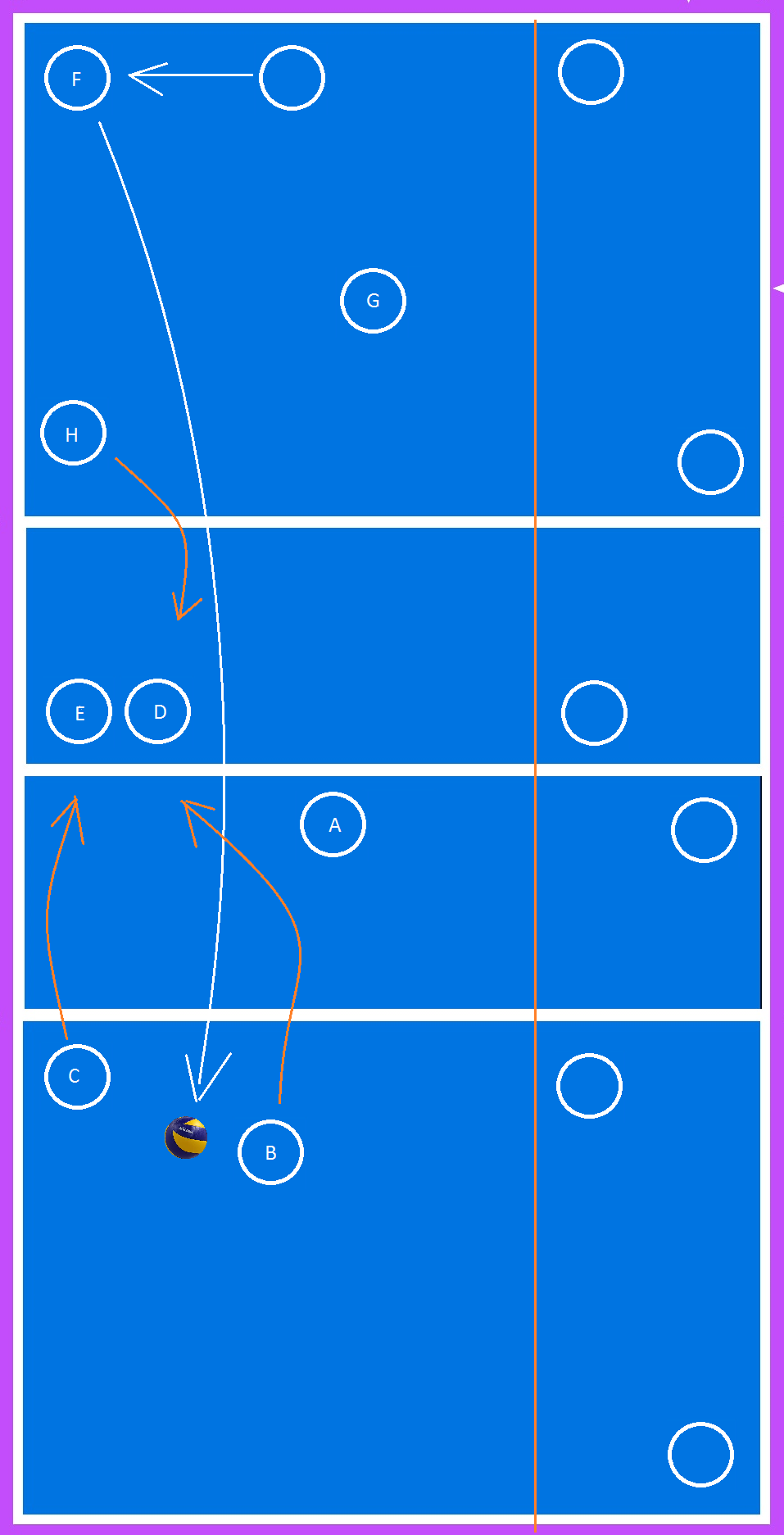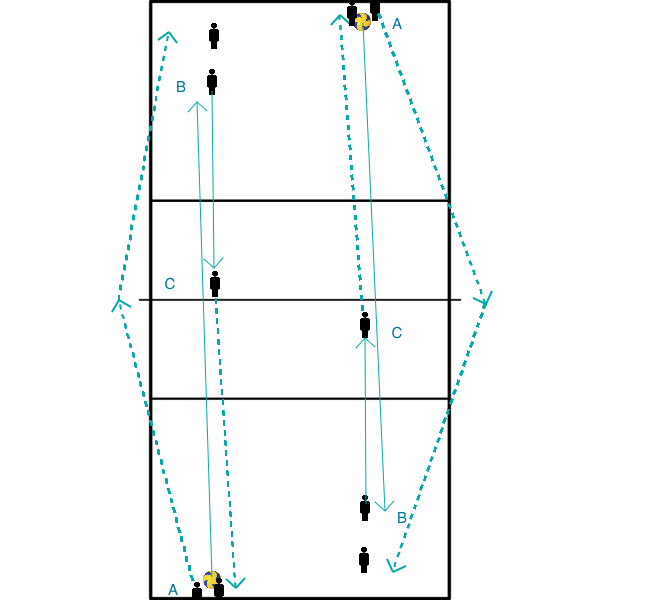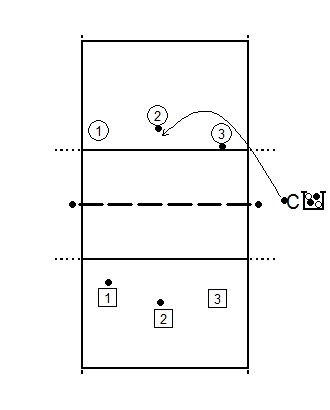Volleyball drills
GOAL
Feet work for block
ORGANIZATION
Two (equal) players are across each other at the net.
EXECUTION
- A player makes a low block movement, after landing a shuffle, steps to the right and takes the ball from across the net where the other player is holding the ball. Shuffle back and transfer the ball under the net to the other player.
- Change every 5 balls
- Each 2 series of 5 taking ball over the net
- A player makes a low block movement, at landing weight more on left leg. Make a step to the right, join legs, and take the ball from other side net where the other player holds the ball up.
- Change every 5 balls
- Each 2 series of 5 taking ball over the net
It is not about the speed but about the movement and the right foot work!!
- Have 3 players walk to net, make a block jump.
- Then the players on position 3 and 4 quickly go to the 3m line, and the trainer throws a ball over the net which has to be passed to the player on position 2 (sv).
- You can still adjust by having the players first stand at the net and have them decide whether the ball should be blocked or defended.
- after the task, 3 new players in the field.
With this exercise, younger children can practice overarm throwing.
- Give everybody a ball and have them show how they play overarm
- Is this not correct (for example, no pizza slice, or under the head), correct them, show how it has to be done.
- Have them throw against the wall, this provides lots of ball contact.
- Make pairs and have them throw over the net, to learn them to play high.
- Meanwhile, correct technique mistakes, but stay positive.
- Ask afterwards what they have learned, to make them think about it again.
Goal of the exercise:
process 2 balls quickly and having to score
Explanation of the exercise:
- Passer and playmaker and attacker all three process 2 balls shortly after each other.
- Passer learns to pass a deepball diagonally backward and a short immediate after (learns to make large angles) the playmaker has to look for the next ball immediately after the first set up.
- The attacker has to go to the back as soon as possible after landing to make another attack.
- As trainer, you can indicate where the balls have to be hit, or the tempo of the set ups, or that the passer has to do attack defense after the first pass and then pass the 2nd ball
- Length of the exercise:
15 minutes.

- divide the group in two.
- The ball has to be passed 10x in 1 group.
- The other group tries to intercept the ball and then pass 10x themselves.
- Two teams are formed.
- The front players of each team have a ball between their feet which does not hit the floor.
- By taking over the ball with the feet in turns, the ball gets to the other side.
- The team that gets to the other side first wins. Does the ball hit the ground? start over.
Play this game in two teams of 3 to 6 players.
The two teams are in the middle of their own side of the field.
They put their hands on each other's shoulder, not everybody has to see the other side of the net properly.
The ball is brought in at one side with an arch.
The ball has to be played over the net in three times, but:
- The players can only get out of the circle when they have first yelled "let go!"
- Where a player who has claimed the ball gets out of the circle, the circle closes
- When the ball has been played over the net, everybody joins the circle
A team deserves a point when they score with the opponent in three times.
To make the exercise run smoothly, it is good if the players give each other high balls and. of course, claim the ball on time. The goal of this game is to have the players communicate about every ball played. Make clear that they have to be aware that not everybody is always in the right position to play the ball
Variation:
Have the circle squat or turn circles on the forefeet when the ball is on the other side of the net.
Suggestions and improvements are welcome.
- every kid takes a ball and stands as close to the wall as possible.
- Try to play the ball against the wall as often (and as fast) as possible
- per pair 1 ball.
- The one person (1) keeps the ball in front of him with stretched arms
- the other stands before him,
- bends the knees
- and tries to play the ball out of the hands of person 1
- someone is one the chest with a hoop
- the sv receives the ball from the back field.
- Then play the ball overarm through the hoop
- Divide your players in pairs
- Per pair 1 ball
- One of the pair is at the net to make a block.
- the other player is on the other side of the net with a ball. This player is at the 3m line and throws the ball over the net.
- The player at the net tries to block the ball.
- 20 balls, then change tasks.

Goal: recognize ball trajectory, QUICKLY assume position.
Ball trajectory: A serves to B, B passes to C.
Walking direction: A, B, C
B moves (before the ball has passed the 3m line of A) to the right position (90%) and is active instead of reactive.
B assumes the correct posture when the ball passes the net
B adjust the correct position and posture in the remaining position (10%).
Possibly build up:
- first B catches ball with bent arms
- B then passes the ball underhand
GOAL
Condition, Feet work, Standing still and Pass
ORGANIZATION
Group of 3. A player in the middle and two others on the outer sideline.
EXECUTION
- Passer walks and shuffles backwards gives pass, turns, and shuffles backwards again for the next pass. etc...
- Pass 15 balls and change after.

This exercise is fun in the warming-up and improves the communication between players.
- 2 teams of 3 persons.
- 2 persons of each team have a ball.
- Can also be done with 4 players and 2 balls, 3 players 1 ball, does also depend on the level of your players
- C has a ball and throws in to one of the teams.
- The goal is that the ball is played over the net in 3 times, in which each person can touch the ball once.
- The one who plays the ball, cannot hold another ball and nobody can hold 2 balls, and no ball is allowed to touch the ground.
- Emphasis is on communication (before and during the game)
- Give the assignment to the teams that they must agree on a strategy how to solve problems?
- For example, the name of the person receiving the ball is called, agreements how to play, etc.
It is a good exercise to look at the solutions the players come up with themselves to solve this difficult problem, or whether they know that to win it is useful to pass to a player who already has a ball and a guarantee for fun in the exercise :-)
- Depending on the level of your players, you can make this game harder by having the last ball calmly.
- If you play this with multiple times, then change the team that lets the ball drop for a different team.
- Teams themselves keep score, and a team scores when the other team drops the ball.







